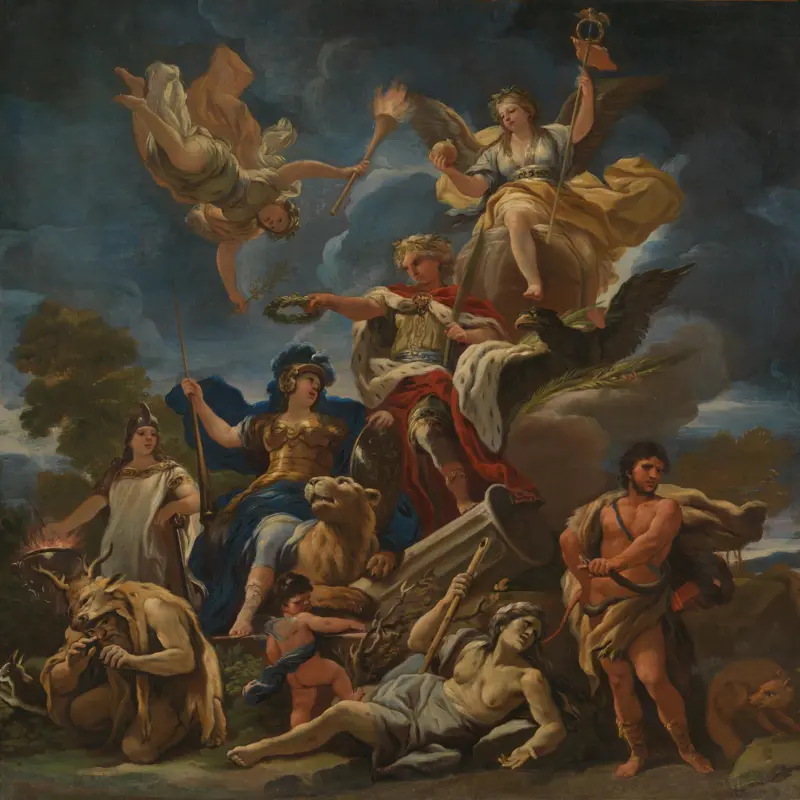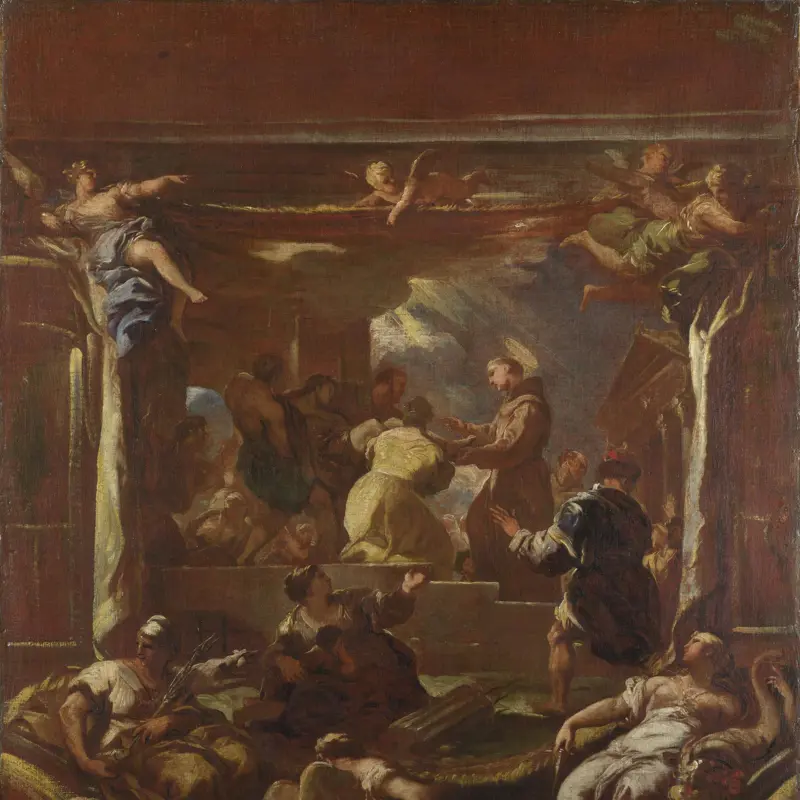Luca Giordano, 'A Homage to Velázquez', about 1692-1700
About the work
Overview
The title of this painting originates from the idea that it portrays Diego Velázquez at the Spanish court, surrounded by royal personages and prominent humanists. The main figures in Velázquez’s Las Meninas (Prado Museum, Madrid) – including Velázquez himself and the young Spanish princess Margarita – were believed to be the central protagonists in this painting too.
This theory has since been discounted. A more convincing interpretation identifies the main figure as the Count of Santisteban, with his daughter and members of his household. He had been ruler (viceroy) of Naples, and owned a ‘large sketch’ by Luca Giordano, the description of which matches this painting. Giordano has included a self portrait: he is the man wearing spectacles lower right.
The painting was thought to be by Velázquez in the nineteenth century, when it was owned by the British artist Sir Edwin Landseer. He, like others, must have admired the work for its confident handling of paint and sketch-like quality – the leaping spaniel in the foreground is a particularly lively detail.
Key facts
Details
- Full title
- A Homage to Velázquez
- Artist
- Luca Giordano
- Artist dates
- 1634 - 1705
- Date made
- About 1692-1700
- Medium and support
- Oil on canvas
- Dimensions
- 205.2 × 182.2 cm
- Acquisition credit
- Presented by Lord Savile, 1895
- Inventory number
- NG1434
- Location
- Not on display
- Collection
- Main Collection
Provenance
Additional information
Text extracted from the ‘Provenance’ section of the catalogue entry in Michael Levey, ‘National Gallery Catalogues: The Seventeenth and Eighteenth Century Italian Schools’, London 1986; for further information, see the full catalogue entry.
Exhibition history
-
2014Loan to Kingston Lacy (2014)Kingston Lacy (National Trust)30 April 2014 - 21 September 2014
-
2018Barbara Walker: Vanishing PointJerwood Gallery20 October 2018 - 6 January 2019
-
2020Masterpieces from the National Gallery, LondonThe National Museum of Western Art18 June 2020 - 18 October 2020The National Museum of Art3 November 2020 - 31 January 2021
-
2021Botticelli to Van Gogh: Masterpieces from the National Gallery, LondonNational Gallery of Australia5 March 2021 - 14 June 2021
Bibliography
-
1906A. de Beruete, Velázquez, London 1906
-
1907R. Fry, 'Art Books of the Month: Books on Painting: Velazquez by A. de Beruete', The Burlington Magazine, X/47, 1907, pp. 326-7
-
1910'Editorial: The National Gallery', The Burlington Magazine, XVIII/91, 1910, pp. 3-4
-
1916R.C. Witt, 'The Cataloguing of the National Gallery', The Burlington Magazine, XXVIII/155, 1916, pp. 190-2
-
1920C.J. Holmes, 'Spanish Painting at Burlington House', The Burlington Magazine, XXXVII/213, 1920, pp. 269-76
-
1938S. Ortolani, Dalla mostra di pittura Napoletana dei secoli XVII, XVIII e XIX, Naples 1938
-
1966O. Ferrari and G. Scavizzi, Luca Giordano, Naples 1966
-
1971M. Levey, The Seventeenth and Eighteenth Century Italian Schools, London 1971
-
1978J. Mills and R. White, 'Organic Analysis in the Arts: Some Further Paint Medium Analyses', National Gallery Technical Bulletin, II, 1978, pp. 71-6
-
1982E. Harris, Velázquez, Oxford 1982
-
1982Whitfield and J. Martineau (eds), Painting in Naples 1606-1705: From Caravaggio to Giordano (exh. cat. Royal Academy of Arts, 2 October - 12 December 1982), London 1982
-
1986Levey, Michael, National Gallery Catalogues: The Seventeenth and Eighteenth Century Italian Schools, London 1986
-
1992O. Ferrari, Luca Giordano: L'opera completa, 2 vols, Naples 1992
-
1994C. Kesser, Las Meninas von Velázquez: Eine Wirkungs und Rezeptionseschichte, Berlin 1994
-
1994Á. Aterido Fernández, 'El verdadero asunto del "homenaje a Velázquez" de Giordano', Archivo español de arte, LVII/268, 1994, pp. 396-9
-
2000V. Lleó Cañal, 'The Painter and the Diplomat: Luca Giordano and the Viceroy, Count of Santisteban', in E. Cropper (ed.), The Diplomacy of Art: Artistic Creation and Politics in Seicento Italy, Bologna 2000, pp. 121-50
-
2001
C. Baker and T. Henry, The National Gallery: Complete Illustrated Catalogue, London 2001
-
2001S. Cassani et al., Luca Giordano, 1634-1705 (exh. cat. Museo di Capodimonte, 3 March - 5 June 2001; Kunsthistorisches Museum, 17 June - 7 October 2001), Naples 2001
-
2002A.E.P. Sánchez, Luca Giordano y España (exh. cat. Palacio Real, 7 March - 2 June 2002), Madrid 2002
-
2007Á. Aterido Fernández, 'El Genio de Rubens pintado por Luca Giordano', Goya, 316-317, 2007, pp. 51-64
-
2007J.J. Urríes, 'El coleccionismo del ilustrado Bernardo de Iriarte', Goya, 319-320, 2007, pp. 259-80
-
2008M.J.M. González, El mercado español de pinturas en el siglo XVII, Madrid 2008
About this record
If you know more about this work or have spotted an error, please contact us. Please note that exhibition histories are listed from 2009 onwards. Bibliographies may not be complete; more comprehensive information is available in the National Gallery Library.














